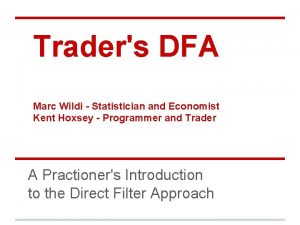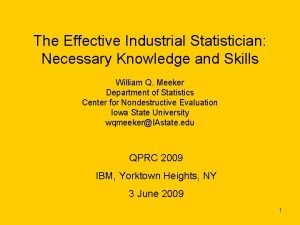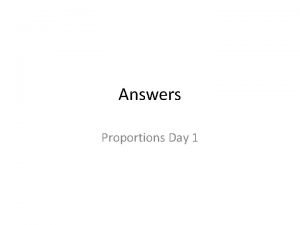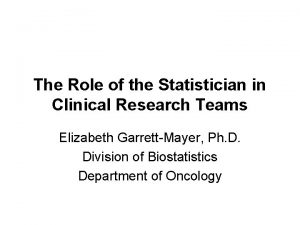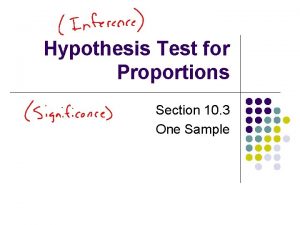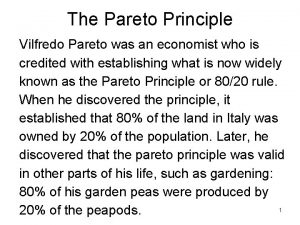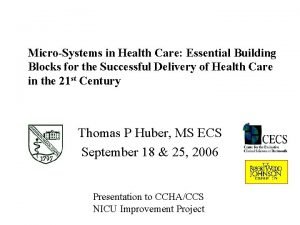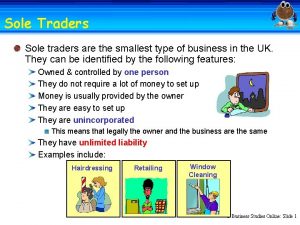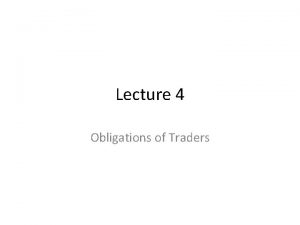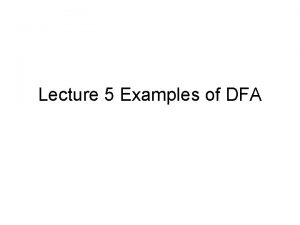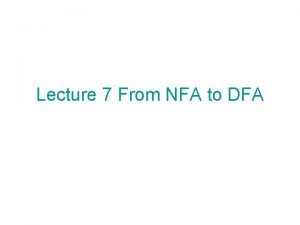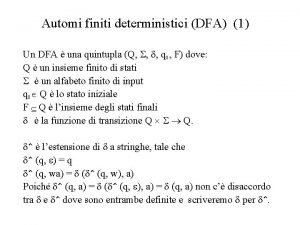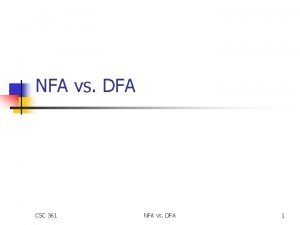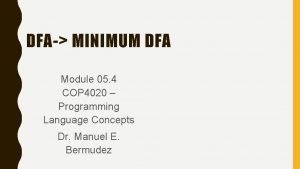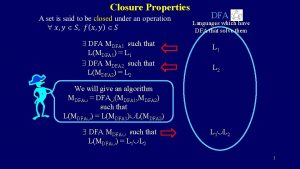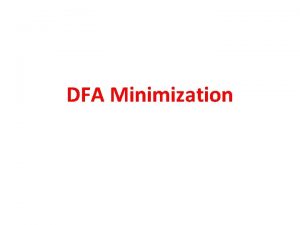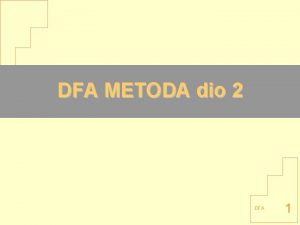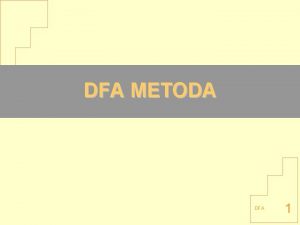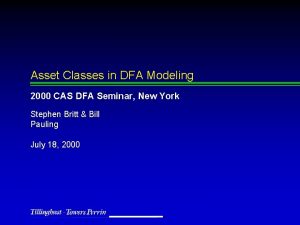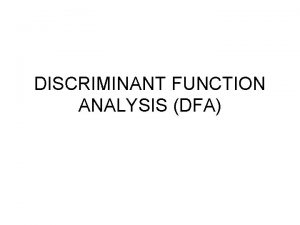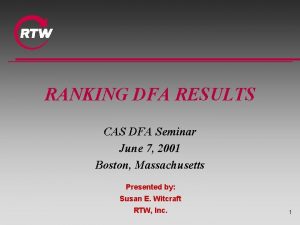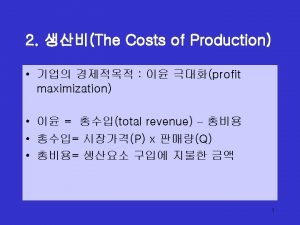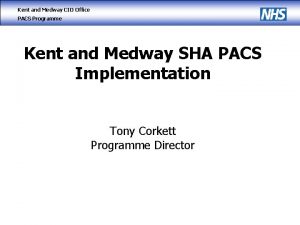Traders DFA Marc Wildi Statistician and Economist Kent
































- Slides: 32

Trader's DFA Marc Wildi - Statistician and Economist Kent Hoxsey - Programmer and Trader A Practioner's Introduction to the Direct Filter Approach

Signalextraction • Noise • Filter • Signal

Signal

Eurostoxx 50, MA(200) Equal-Weights (Faber 2009)

Real-Time Signalextraction

Eurostoxx 50, MA(200) Symmetric and MA(200) Real-Time

Real-Time Perspective • Turning-points (trades) are delayed o Performances affected • Delay could be decreased by selecting shorter filters o Generate more `false’ alarms o Performances affected • Tradeoff: speed/timeliness vs. smoothness/reliability

Frequency Domain • Timeliness • Reliability • Both!

Real-Time Signalextraction Frequency Domain

Optimization Criterion: Mean-Square

Objectives 1. Real-time filters which are `fast’ o Detect turning-points timely 2. Real-time filters which are `reliable’ o Impose strong noise suppression

Cosine Law applied to

Decomposition of Mean-Square Criterion

Timeliness and Noise Suppression

Control: Interfacing with the Criterion

Latest Developments (2011, 2012) • Fast closed-form solutions o I-MDFA • Generic Approach o Replicate model-based approaches, HP-designs, CFdesigns (see http: //blog. zhaw. ch/idp/sefblog) o Customize traditional mean-square approaches • Alleviate/control overfitting o Regularization o Rmetrics-2012

Background • SEFBlog: o http: //blog. zhaw. ch/idp/sefblog o Articles, books, applications, R-code, tutorials • Recent Articles: o Wildi/Mc. Elroy (2012) § http: //blog. zhaw. ch/idp/sefblog/index. php? /archives/263 -On-a-Trilemma-Between-Accuracy, -Timeliness-and. Smoothness-in-Real-Time-Forecasting-and-Signal. Extraction. html o Wildi (2012) § http: //blog. zhaw. ch/idp/sefblog/index. php? /archives/262 -Up-Dated-I-MDFA-Code-and-Working-Paper. html

Background • R-Code/tutorials o Check the categories `I-MDFA code repository’ or `tutorial’ on SEFBlog • Macro-indicators o http: //www. idp. zhaw. ch/usri o http: //www. idp. zhaw. ch/euri • Trading o http: //www. idp. zhaw. ch/MDFA-XT o http: //blog. zhaw. ch/idp/sefblog/index. php? /archives/1 57 -A-Generalization-of-the-GARCH-in-Mean-Model. Vola-in-I-MDFA-filter. html

A Hybrid Approach • i. Metrica o Access to State Space, ARIMA, I-MDFA, Stochastic Volatility, Hybrid o Chris Blakely: www. cd-blakely. com

Vola in I-MDFA Described in a blog post, and then in more detail later in a conference presentation.

Exercise: Reproduce the Example Code available on SEF-Blog at: http: //blog. zhaw. ch/idp/sefblog/uploads/Vola_in_I-MDFA_prototype 1. r Runs as-is, but you need a "trading" function Zero-crossing function: start with your filter weights and data series create a vector of NAs as long as your index to be your signal set signal to 1 where filtered data > 0 set signal to 0 where filtered data < 0 fill your NAs - na. locf() is your best friend Not sophisticated, but tricky: watch your lags Veddy importante: signal *today* means returns *tomorrow*

Exercise: Reproduce the Example (2)

Corollary: Understand the Behavior Reference code runs a multi-stage loop calculates filters for combinations of params runs an optimizer over the param space Effective, but not illuminating for me parameter changes not intuitive (for me) needed a feel for sensitivity And I just happen to have a lot of machines. . . easy code changes: expand. grid and foreach lots of cpu time eventually, lots of results

Finale: Descend into Obsession

Finale: Descend into Obsession

Finale: Descend into Obsession

Finale: Descend into Obsession

Finale: Descend into Obsession

Finale: Descend into Obsession

Finale: Descend into Obsession

Results: Qualitative Analysis of M/S

Results: Qualitative Analysis of M/S
 Marc wildi
Marc wildi Industrial statistician
Industrial statistician A statistician read that at least 77
A statistician read that at least 77 Clinical research statistician
Clinical research statistician Independent statistician
Independent statistician How are they connected
How are they connected A statistician read that at least 77
A statistician read that at least 77 Thinking like an economist summary
Thinking like an economist summary Thinking like an economist ppt
Thinking like an economist ppt Pareto economist
Pareto economist Planned economy or planned destruction political cartoon
Planned economy or planned destruction political cartoon Eoc a sample
Eoc a sample The galloping snail political cartoon analysis
The galloping snail political cartoon analysis Thinking like an economist chapter 2
Thinking like an economist chapter 2 The young economist's guide to professional etiquette
The young economist's guide to professional etiquette Thinking like an economist chapter 1
Thinking like an economist chapter 1 Chapter 2 thinking like an economist
Chapter 2 thinking like an economist Chapter 2 thinking like an economist summary
Chapter 2 thinking like an economist summary Jane carter labor economist
Jane carter labor economist Economist.com
Economist.com Economist.com
Economist.com Economist china trade
Economist china trade Tragedy of the commons example
Tragedy of the commons example The tragedy of commons
The tragedy of commons Hardin economist
Hardin economist Hardin economist
Hardin economist Thinking like an economist chapter 2
Thinking like an economist chapter 2 Microsystem in healthcare
Microsystem in healthcare Ideolohiyang komunismo
Ideolohiyang komunismo Famous sole traders
Famous sole traders How did the minoans and phoenicians influence
How did the minoans and phoenicians influence Northwind traders
Northwind traders Early chinese traders who visited mindoro called our nation
Early chinese traders who visited mindoro called our nation
